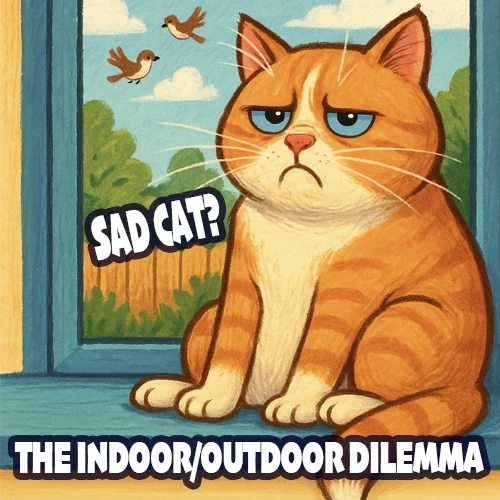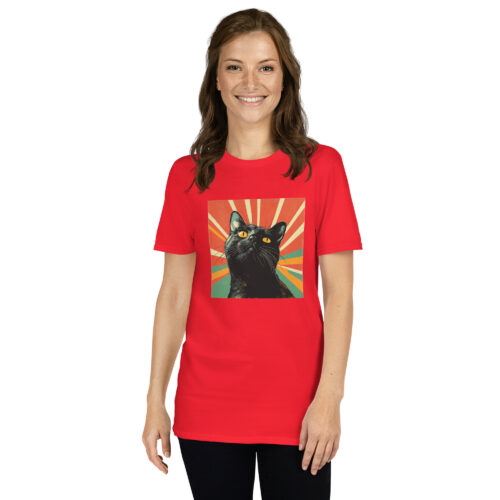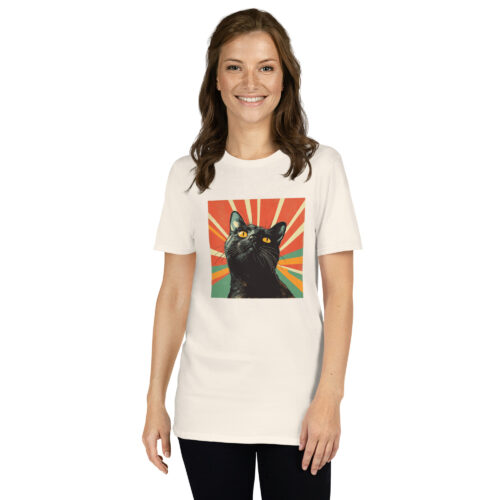
Cat TV: Are YouTube Bird Videos Good or Bad for Your Kitty?
Table of Contents
- The Rise of Cat TV: How Did We Get Here?
- The Potential Benefits: Why Cat TV Might Be Paw-some
- Potential Drawbacks: When Screen Time Becomes Problematic
- How Different Cats Respond to Cat TV
- Finding the Right Balance: Best Practices for Cat TV
- What Science Says About Cats and Screens
- Recommendations: Top Cat TV Channels Worth Checking Out
- DIY Cat TV Alternatives
- What Pet Owners Are Saying Online
- The Bottom Line: Is Cat TV Right for Your Feline?
Key Takeaways
- Individual responses vary – Some cats love screen time while others may become frustrated or overstimulated
- Moderation is important – Limit Cat TV sessions to 10-15 minutes and monitor your cat’s behavior
- Content matters – Different cats prefer different types of videos (birds, fish, squirrels)
- Follow-up with real play – Cat TV should supplement, not replace, interactive playtime
- Signs of stress – Excessive vocalization, aggressive tail twitching, or pacing may indicate your cat is getting overstimulated
Have you ever caught your feline friend staring intently at your screen, paws twitching as birds flit across the display? You’re not alone! The phenomenon of “Cat TV” – specially designed videos for our feline companions – has exploded in popularity over the past few years. But as responsible pet parents, we have to ask: is this digital enrichment actually beneficial, or could it be causing more harm than good?
Today, we’re diving whiskers-first into the fascinating world of cats and screens to help you determine whether those chirping bird videos are a purr-fect addition to your kitty’s enrichment routine or just another digital distraction.
The Rise of Cat TV: How Did We Get Here?
Remember the days when cats simply gazed out windows for entertainment? That classic pastime hasn’t gone anywhere, but our increasingly digital world has introduced new options for indoor cat enrichment. YouTube channels dedicated to feline viewers have amassed millions of views, with some videos stretching to 8+ hours of bird, fish, and rodent footage designed to captivate your cat’s attention.
The concept makes sense: indoor cats often lack the stimulation their outdoor counterparts enjoy naturally. A window view might offer occasional excitement when a bird lands on the sill, but YouTube brings a constant parade of prey-like movements right into your living room, available 24/7.
Research from feline behavior specialists confirms this attraction: cats are visual hunters by nature with eyes specifically designed to detect small, quick movements – exactly what these videos provide. Their natural predatory instincts make these videos particularly engaging.
The Potential Benefits: Why Cat TV Might Be Paw-some
Before we get into concerns, let’s look at why many cat owners swear by these digital playthings:
Mental Stimulation for Indoor Cats
Indoor cats live significantly longer, safer lives than outdoor cats – but they can suffer from boredom. Mental stimulation is crucial for preventing behavioral problems, and Cat TV offers:
- Predatory Outlet: Cats can engage their hunting instincts without actually harming wildlife
- Cognitive Engagement: Tracking movement exercises their brain and keeps them alert
- Entertainment During Alone Time: Videos can provide companionship when you’re away
- Reduced Destructive Behaviors: A stimulated cat is less likely to seek entertainment by shredding your furniture
Many cat owners in online forums and reviews have reported similar experiences with their pets. As one commenter on a popular cat forum noted, “Ever since I started playing bird videos during the day, my cat has stopped knocking things off shelves. He seems much more content with this entertainment.”
Stress Reduction for Some Cats
Interestingly, some cats seem to find these videos calming. The predictable movement and engaging visuals can create a soothing environment, especially for cats that:
- Live in apartments without window access
- Are recovering from illness or surgery
- Have anxiety or stress-related issues
- Need distraction during thunderstorms or other stressful events
Potential Drawbacks: When Screen Time Becomes Problematic
As with anything in the cat care world, what works for one feline might not work for another. Some concerning aspects of Cat TV include:
Frustration and Overstimulation
Veterinary experts caution that not all cats respond positively to these videos. Some can become visibly agitated, vocalize excessively, pace, or show signs of frustration because they can’t actually catch what they’re seeing.
Signs your cat might be getting overstimulated include:
- Tail twitching aggressively (different from playful twitching)
- Dilated pupils that stay dilated even in bright light
- Excessive vocalization or growling
- Redirected aggression toward other pets or people
- Pacing or showing signs of anxiety after watching
Potential for Obsessive Behavior
Just like humans can develop unhealthy relationships with screens, some cats seem to become fixated on Cat TV to an concerning degree.
In a popular Reddit thread about Cat TV, multiple cat owners shared stories of concerning behavior. One pet parent described how their cat would sit in front of the TV for hours, barely blinking and ignoring food and water. When the video ended, their cat would paw at the screen and meow incessantly – suggesting a need for boundaries with screen time.
Screen Time vs. Interactive Play
Perhaps the biggest concern among feline behaviorists isn’t that Cat TV is inherently harmful – it’s that it might replace more beneficial forms of enrichment.
According to the International Association of Animal Behavior Consultants, no video can replace the bond-building benefits of interactive play or the full-body exercise of chasing physical toys. Cat TV should supplement, not replace, physical play and interaction.
How Different Cats Respond to Cat TV
Not all cats react the same way to videos. Here’s a breakdown of how various feline personalities typically engage with on-screen entertainment:
| Cat Type | Typical Reaction to Cat TV | Recommendation |
|---|---|---|
| Young, high-energy cats | Often highly engaged, may paw at screen | Limit sessions to prevent frustration |
| Senior cats | May watch calmly, less physical response | Good option for mental stimulation |
| Timid/anxious cats | Results vary – some find it calming, others stressful | Monitor closely for signs of stress |
| Former outdoor cats | Often extremely interested, may become frustrated | Pair with physical activity afterward |
| Multi-cat households | May cause resource guarding of viewing spots | Provide multiple viewing options |
Finding the Right Balance: Best Practices for Cat TV
If you’re considering making Cat TV part of your kitty’s routine, here are our top recommendations for keeping it healthy and beneficial:
1. Time Limits Matter
Just as we set screen time limits for children, consider setting boundaries for your cat’s viewing habits:
- Start with 10-15 minute sessions
- Watch for signs of frustration or overstimulation
- Never leave Cat TV on 24/7 – cats need sleep cycles too!
- Try to schedule sessions at the same time each day
2. Choose Content Wisely
Not all Cat TV is created equal! Consider these factors when selecting videos:
- Speed of movement: Some cats prefer slower-moving targets, while others enjoy faster action
- Type of prey: Does your cat go crazy for birds, or are they more interested in mice or fish?
- Sound quality: Some cats respond strongly to realistic chirping or squeaking
- Screen brightness: Lower brightness can be easier on feline eyes
3. Follow Up with Interactive Play
The most successful Cat TV experiences are those followed by actual physical play. This gives your cat:
- A chance to “catch” something after being stimulated by the video
- Physical exercise to complement the mental stimulation
- A way to release any built-up hunting energy
- Bonding time with you after solo screen time
What Science Says About Cats and Screens
While research specifically on cats watching videos is still emerging, we do know some interesting facts about feline vision and screens:
- Cats can see images on modern screens (older TVs had refresh rates too slow for cats to perceive motion properly)
- Felines process visual information differently than humans, with greater sensitivity to motion
- Cats can’t focus on objects as close to their faces as humans can, so they may sit at an optimal distance from screens
- Blue and green colors are more visible to cats than reds (though they don’t see color as vibrantly as we do)
A 2021 study published in the journal Applied Animal Behaviour Science found that a majority of cats showed interest in specially designed videos, but the duration and intensity of that interest varied dramatically between individuals.
Recommendations: Top Cat TV Channels Worth Checking Out
If you’re ready to experiment with Cat TV, here are some of the most popular channels that have earned feline approval:
Paul Dinning Wildlife
With over 1 billion views, Paul’s channel offers incredibly high-quality bird videos filmed in natural settings. The birds move naturally, and the authentic sounds seem particularly engaging for cats.
Cat Entertainment TV
This channel focuses exclusively on content for cats, with videos specifically designed to capture and maintain feline attention through extensive testing with real cats.
Relax My Cat
Perfect for anxious kitties, this channel combines visual stimulation with calming music designed to reduce stress in cats.
DIY Cat TV Alternatives
Not keen on more screen time in your home? Try these screen-free alternatives that provide similar benefits:
- Window perches with bird feeders installed outside
- Cat-specific DVD players that play on repeat without requiring your TV
- Natural fish tanks (securely covered, of course!)
- Kinetic toys that move unpredictably, mimicking prey movement
- Puzzle feeders that engage hunting and problem-solving instincts
What Pet Owners Are Saying Online
A quick search through pet forums and video comments reveals diverse experiences with Cat TV:
From YouTube comments on popular Cat TV videos:
“My cat watches these videos every morning while I get ready for work. It’s become such a routine that she sits by the TV and meows until I turn it on!”
From a popular cat forum discussion:
“Our senior cat hasn’t been interested in toys lately, but she perks up for fish videos. She gently paws at the screen and makes those excited chirping sounds.”
From an Amazon review of a Cat DVD:
“Had to switch from bird videos to fish videos because my cat was getting too stimulated. The slower movements seem to be a better match for his temperament.”
The Bottom Line: Is Cat TV Right for Your Feline?
Like most aspects of cat care, there’s no one-size-fits-all answer. Cat TV can be:
- A wonderful enrichment tool for some cats
- A source of frustration for others
- Best used in moderation for most
The key is observation. Watch how your individual cat responds, adjust accordingly, and remember that even the most captivating video can’t replace real interactive play and human bonding time.
As technology continues to advance, we’ll likely see even more sophisticated options for digital cat entertainment. There are already apps that let cats “catch” digital prey on tablets, and who knows what the future might bring!
For now, if your furry friend enjoys their screen time without signs of stress, there’s no reason not to include some Cat TV in their enrichment rotation – just keep it balanced with plenty of real-world play, too.
What’s your experience with Cat TV? Has your cat discovered these videos yet? Share your stories in the comments below – we’d love to hear how your feline friend responds to digital birds and fish!
The Kitty Kiosk team recommends consulting with your veterinarian if you have concerns about your cat’s behavior or stress levels.
Loved this post? Explore more helpful cat care tips on our cat blog and join our community of cat lovers to share stories and advice!
Disclosure: This post contains affiliate links. If you purchase through these links, we may earn a commission at no extra cost to you.










